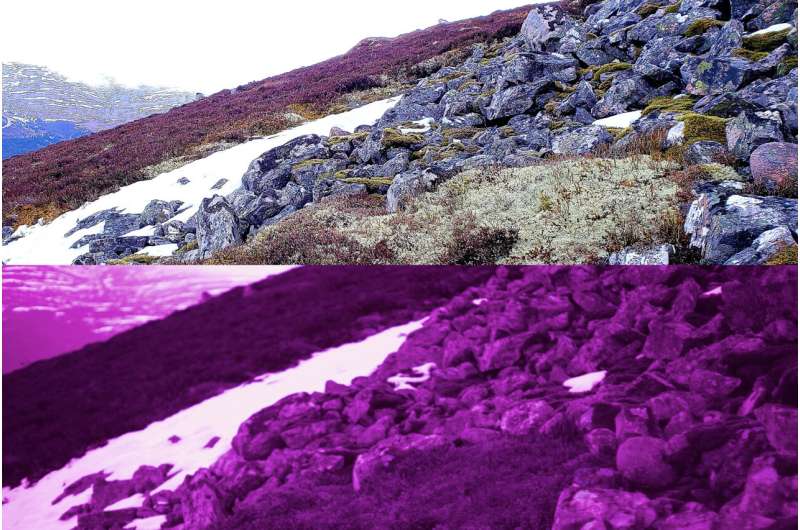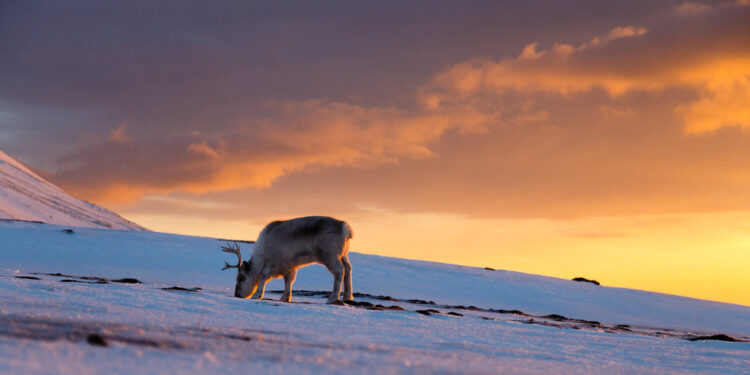A reindeer in Svalbard, Norway grazes on lichens in the snow during the low light of winter. Credit: Espen Bergersen
When Santa’s exhausted reindeer finally land their sleigh in the deep snow of the North Pole early on Christmas morning, it is not Rudolph’s radiant red nose that will help them find sustenance in this barren landscape.
Instead, researchers from Dartmouth and the University of St. Andrews in Scotland report that the eyes of Rudolph and his reindeer brothers may have evolved so that they could spot their favorite food during the dark, snowy winters of the ‘Arctic, according to a new study published in the journal. i-Perception.
The results help explain the long-standing scientific mystery of why reindeer can see light in the ultraviolet (UV) spectrum and add intrigue to the smiling aerial ungulates popularized in Robert L.’s classic story. May, who graduated from Dartmouth in 1926.
“Reindeer are so cool, but a lot of people only think about them at Christmas,” says Nathaniel Dominy, first author of the study and the Charles Hansen Professor of Anthropology at Dartmouth. “Now is a good time to alert people to their extraordinary visual system.”
Reindeer subsist primarily on reindeer moss, or Cladonia rangiferina, which is not a moss but actually a species of fusion of algae and fungi known as lichen. C. rangiferina forms thick, crusty mats in northern latitudes and is so integral to reindeer survival that even its official name comes from the scientific term for reindeer, Rangifer.
The researchers worked in the Cairngorms mountains in the Scottish Highlands, home to Britain’s only reindeer herd – reintroduced from Scandinavia after being hunted to extinction locally – and more than 1,500 species of lichens. Despite these options, reindeer in the Cairngorms rely on C. rangiferina during winter.
“A particular trait of reindeer is their dependence on this type of lichen,” explains Dominy. “It’s unusual for an animal to feed on so much lichen, let alone such a large mammal.”
To the human eye, white lichen is invisible against the snowy background of an Arctic winter.

Because reindeer can see in the ultraviolet spectrum, their UV-absorbing food source, lichen, appears dark against the snowy Arctic landscape. Credit: Nathaniel Dominy
But Dominy and co-authors Catherine Hobaiter and Julie Harris of St. Andrews discovered that C. rangiferina and a few other lichen species that supplement reindeer diets absorb UV light. Spectral data from lichens and light filters calibrated to mimic reindeer vision revealed that these organisms appear as dark spots on an otherwise bright landscape, making them easier to locate.
“Getting a visual approximation of how reindeer might see the world is something that other studies have never done before,” says Dominy, who published a paper in 2015 on how Rudolph’s red nose would have acted as an effective fog light in the winter mist. .
“If you can put yourself in their shoes looking at this white landscape, you would want to have a direct path to your food,” he says. “Reindeer don’t want to waste their energy searching for food in a cold, arid environment. If they can see the lichens from afar, it gives them a big advantage, allowing them to conserve precious calories at a time when the food is scarce.”
Previous research has shown that reindeer’s eyes change between summer and winter, Dominy says. Their tapetum – the light-enhancing membrane that gives many animals “bright” eyes – changes in winter from the golden color of most animals to a bright blue that is thought to amplify the low light of the polar winter .
“If the color of light in the environment is primarily blue, then it makes sense for the eye to emphasize the blue color to ensure that the reindeer’s photoreceptors maximize these wavelengths,” Dominy explains.
But the blue tapetum also lets up to 60% of ultraviolet light pass to the eye’s color sensors. This means that reindeer see the winter world as a shade of purple, in the same way a person would see a room with black light: UV-reflecting surfaces such as snow glow brightly while UV-absorbing surfaces UV are very dark.
The researchers recount how scientists sought to understand why the eyes of a daytime active Arctic animal would be receptive to UV light reflecting off every snow-covered surface. But their study suggests the answer has to do with what UV light doesn’t reflect off: C. rangiferina and other bushy lichens.
Given the importance of lichens in the reindeer’s diet, the researchers report, it is possible that the animal’s eyes are optimized to distinguish this staple food at the time of year when it would be most difficult to find.
So while the luminescent nose of the most famous reindeer of all “can light Santa’s path,” the researchers write, “it’s Rudolph’s blue eyes that allow him to find dinner after a long Christmas season.” .
More information:
Nathaniel J. Dominy et al, Reindeer and the quest for Scottish enrichment, i-Perception (2023). DOI: 10.1177/20416695231218520
Provided by Dartmouth College
Quote: Reindeer vision may have evolved to spot their favorite food in the snowy darkness of winter (December 15, 2023) retrieved December 16, 2023 from
This document is subject to copyright. Apart from fair use for private study or research purposes, no part may be reproduced without written permission. The content is provided for information only.



